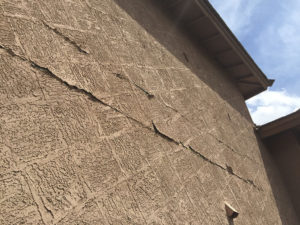Stucco Cracking and the Causations
 Stucco is widely used all over the world as an exterior cladding because of its aesthetic appeal, durability, fire resistance, design flexibility, low cost and ease of maintenance. Stucco is by nature hard and strong, but it is relatively thin and brittle and, will crack when subjected to stresses that exceed its tensile strength.
Stucco is widely used all over the world as an exterior cladding because of its aesthetic appeal, durability, fire resistance, design flexibility, low cost and ease of maintenance. Stucco is by nature hard and strong, but it is relatively thin and brittle and, will crack when subjected to stresses that exceed its tensile strength.
Assessing “causation” of plaster cracking is, at times, very complex, difficult and extremely limited when restricted to a visual inspection only. Contrary to belief, when evaluating the nature of Portland cement plaster cracking, one must consider other factors. Plaster cracks form when a stronger force exceeds the restraint capacity of the Portland cement.
It is important to remember that stucco is not structural, it is a finish. The International Building Code (IBC) and American Society for Testing and Materials (ASTM) do not require any specific flexural resistance, compression or tensile strength for Portland cement plaster because they do not value it structurally, unlike steel or concrete. Plaster cracks are stress-released energy. Although it contributes to and provides some form of shear value against wind or seismic forces, it carries no structural value.
There are two fundamental types of stresses that cause stucco cracks.
Internal and External Stress Cracks.
- INTERNAL STRESSES
Internal stresses are due to the natural curing and drying hydration process of stucco application, which usually occurs within 1 to 2 days. This is why the California Building Code and ASTM C 926 call for 48 hours of moisture curing for the hydration of the stucco application. This 48-hour period is when most stucco “shrinkage cracks” occur. This shrinkage, when controlled, may still create hairline cracks in different directions and patterns depending on temperature and wind speed. All internal stress cracks will appear within 14 days. Once the 14-day period is reached, “external stress cracks” will begin to develop. - EXTERNAL STRESSES
External stresses are due to the transfer of outside forces into the stucco membrane. Common examples are at the corners of windows and doors. These stresses can cause movement within the stucco, which can result in wider cracks than internally generated cracks. The following are common, but not exclusive, sources of external stresses that are associated with stucco cracking.
Plaster crack development is caused by underlying lateral and perpendicular forces. These forces are influenced by building structural components’ behavior beneath the plaster system. Plaster walls become an illustrative canvas, charting out graphic diagrams and outlines of stress relief-type cracking. Plaster cracks are visual indicators of building structural movements behind the 7/8” stucco wall membrane. The ability of Portland cement plaster to flex or resist perpendicular forces (flexural) is commonly overlooked and overestimated.
Essentially, Portland cement plaster can be extremely hard, solid, durable, and weather-efficient. However, it can at the same time be rigid and inflexible when flexurally-challenged. The repercussion of a plaster wall’s inability to flex or bend is to crack. A plaster crack is the symptom of movement, not the primary movement.
- Soil movement: Seismic events, settlement, and expansion of soil under the building can cause the foundation to move slightly.
- Loads on building: Live loads (i.e., traffic, furniture, and occupants) and dead loads (i.e., roof tile and equipment vibration).
- Wind and solar energy: Wind loads can place pressure on stucco wall panels, due to the kinetic energy force. Solar energy is the primary cause for external stress on the building and can create stucco cracks.
All building materials expand and contract with changes in temperature, but each material expands at its own rate depending on the thermal coefficient rating. An aluminum and vinyl window frame in a stucco opening is usually separated due to movement from the stucco panel by temperature. In most cases, the movement being considered is perpendicular to the joint, but in fact, the greatest movement is parallel to the joint because of the difference in expansion of the aluminum and vinyl window systems and the stucco wall thermal coefficient rating.
The parallel movements of a window frame can cause diagonal stucco cracks at the window frame joint corners where the window frame’s (corners) perpendicular intersections meet. This diagonal cracking pattern is ignored by some experts who do not know the different coefficient ratings and blame the stucco mix or the application. When making a decision about building design and material selection, this different coefficient rate of expansion must be considered. J-Trim and backer rod systems around window frames are the most important factors. Including two pieced expansion joints and control joints is helpful, but there is no guarantee it will stop underlying movement.
The parallel movement between window frames and stucco terminations breaks the stucco bond and can allow water to travel directly onto the weather-resistant barrier/paper products, which cannot perform as a waterproofing membrane.
Weather-resistant barriers were never designed as waterproofing material for many good reasons. If a waterproofing material is installed in place of a weather-resistant barrier, it could lead to mold and other issues.
In addition, weather-resistant barriers have hundreds of linear feet of dry, unsealed laps that can leak vertically and horizontally. There are also thousands of staples, nails or screw fasteners that do not self-seal once they penetrate the weather-resistant barrier. This is the main reason why we need to seal window frame perimeters to the stucco and all other first lines of defense building components that come into contact with the termination of the stucco membrane.
Contact Terra-Petra Waterproofing Division for further information regarding the use of proper waterproofing measures to prevent or mitigate stucco cracking.

